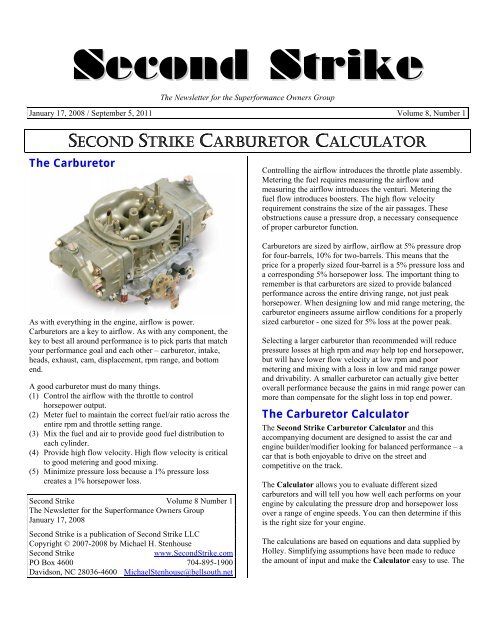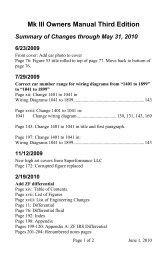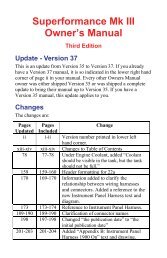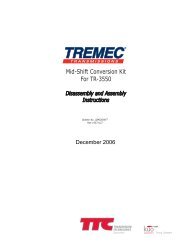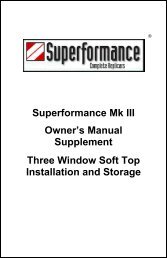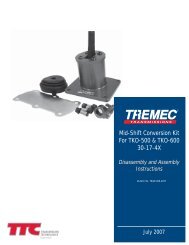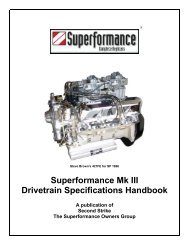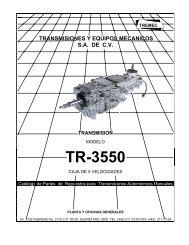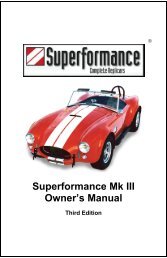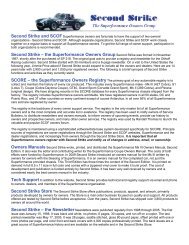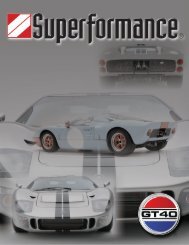Carburetor Calculator - Second Strike
Carburetor Calculator - Second Strike
Carburetor Calculator - Second Strike
Create successful ePaper yourself
Turn your PDF publications into a flip-book with our unique Google optimized e-Paper software.
<strong>Second</strong> <strong>Strike</strong><br />
The Newsletter for the Superformance Owners Group<br />
January 17, 2008 / September 5, 2011 Volume 8, Number 1<br />
SECOND STRIKE CARBURETOR CALCULATOR<br />
The <strong>Carburetor</strong><br />
Controlling the airflow introduces the throttle plate assembly.<br />
Metering the fuel requires measuring the airflow and<br />
measuring the airflow introduces the venturi. Metering the<br />
fuel flow introduces boosters. The high flow velocity<br />
requirement constrains the size of the air passages. These<br />
obstructions cause a pressure drop, a necessary consequence<br />
of proper carburetor function.<br />
As with everything in the engine, airflow is power.<br />
<strong>Carburetor</strong>s are a key to airflow. As with any component, the<br />
key to best all around performance is to pick parts that match<br />
your performance goal and each other – carburetor, intake,<br />
heads, exhaust, cam, displacement, rpm range, and bottom<br />
end.<br />
A good carburetor must do many things.<br />
(1) Control the airflow with the throttle to control<br />
horsepower output.<br />
(2) Meter fuel to maintain the correct fuel/air ratio across the<br />
entire rpm and throttle setting range.<br />
(3) Mix the fuel and air to provide good fuel distribution to<br />
each cylinder.<br />
(4) Provide high flow velocity. High flow velocity is critical<br />
to good metering and good mixing.<br />
(5) Minimize pressure loss because a 1% pressure loss<br />
creates a 1% horsepower loss.<br />
<strong>Second</strong> <strong>Strike</strong> Volume 8 Number 1<br />
The Newsletter for the Superformance Owners Group<br />
January 17, 2008<br />
<strong>Second</strong> <strong>Strike</strong> is a publication of <strong>Second</strong> <strong>Strike</strong> LLC<br />
Copyright © 2007-2008 by Michael H. Stenhouse<br />
<strong>Second</strong> <strong>Strike</strong><br />
www.<strong>Second</strong><strong>Strike</strong>.com<br />
PO Box 4600 704-895-1900<br />
Davidson, NC 28036-4600 MichaelStenhouse@bellsouth.net<br />
<strong>Carburetor</strong>s are sized by airflow, airflow at 5% pressure drop<br />
for four-barrels, 10% for two-barrels. This means that the<br />
price for a properly sized four-barrel is a 5% pressure loss and<br />
a corresponding 5% horsepower loss. The important thing to<br />
remember is that carburetors are sized to provide balanced<br />
performance across the entire driving range, not just peak<br />
horsepower. When designing low and mid range metering, the<br />
carburetor engineers assume airflow conditions for a properly<br />
sized carburetor - one sized for 5% loss at the power peak.<br />
Selecting a larger carburetor than recommended will reduce<br />
pressure losses at high rpm and may help top end horsepower,<br />
but will have lower flow velocity at low rpm and poor<br />
metering and mixing with a loss in low and mid range power<br />
and drivability. A smaller carburetor can actually give better<br />
overall performance because the gains in mid range power can<br />
more than compensate for the slight loss in top end power.<br />
The <strong>Carburetor</strong> <strong>Calculator</strong><br />
The <strong>Second</strong> <strong>Strike</strong> <strong>Carburetor</strong> <strong>Calculator</strong> and this<br />
accompanying document are designed to assist the car and<br />
engine builder/modifier looking for balanced performance – a<br />
car that is both enjoyable to drive on the street and<br />
competitive on the track.<br />
The <strong>Calculator</strong> allows you to evaluate different sized<br />
carburetors and will tell you how well each performs on your<br />
engine by calculating the pressure drop and horsepower loss<br />
over a range of engine speeds. You can then determine if this<br />
is the right size for your engine.<br />
The calculations are based on equations and data supplied by<br />
Holley. Simplifying assumptions have been made to reduce<br />
the amount of input and make the <strong>Calculator</strong> easy to use. The
<strong>Second</strong> <strong>Strike</strong> Page 2<br />
The Newsletter for the Superformance Owners Group January 17, 2008 / September 5, 2011<br />
mathematical basis for the calculations is contained in the<br />
Technical section for those who are interested.<br />
The <strong>Calculator</strong> is designed for normally aspirated engines<br />
with one or more carburetors drawing through a common<br />
plenum, or fuel injection with a single common throttle body.<br />
It is not designed for blowers, turbos, or nitrous or for<br />
individual runner systems such as Weber carburetors or multistack<br />
fuel injection.<br />
The <strong>Carburetor</strong> <strong>Calculator</strong> is on www.<strong>Second</strong><strong>Strike</strong>.com<br />
under the Technical menu item.<br />
If you have net installed horsepower (with air cleaner,<br />
accessories and road exhaust system installed), increase the<br />
net installed horsepower by 15% to get gross horsepower.<br />
If you have rear wheel horsepower, increase the rear wheel<br />
horsepower by 25%. This does not have to be exact. The<br />
horsepower is only used to calculate the horsepower loss.<br />
Cubic Inch Displacement<br />
Specify the actual cubic inch displacement of the engine.<br />
Engine Type<br />
The engine type is used to approximate the volumetric<br />
efficiency (VE) curve. The choices are:<br />
Street<br />
Stock street engines.<br />
High Performance Street<br />
Modified engine suitable for street driving. Upgraded heads,<br />
header, cam, intake, and carburetor. For 1970’s vintage<br />
performance parts.<br />
High Performance Street/Track<br />
Modified engine suitable for street and track driving.<br />
Upgraded heads, header, cam, intake, and carburetor. For<br />
modern performance parts.<br />
Race<br />
Modified engine not suitable for street driving.<br />
Ram Tuned Race<br />
Modified engine with intake and exhaust runner lengths ram<br />
tuned for peak power rpm.<br />
Input<br />
Specify Engine<br />
Peak Horsepower at rpm<br />
Specify the peak horsepower and the rpm that the peak<br />
horsepower occurs. This should be the gross horsepower -<br />
dyno horsepower at the flywheel without installation losses<br />
(without air cleaner and accessories, with open headers).<br />
See Volumetric Efficiency in the Technical section for<br />
details.<br />
Specify <strong>Carburetor</strong><br />
CFM Rating of <strong>Carburetor</strong><br />
<strong>Carburetor</strong>s are rated in airflow capacity stated in cubic feet<br />
per minute (CFM). If you have multiple carburetors, input the<br />
CFM rating of the individual carburetor.<br />
<strong>Carburetor</strong> type<br />
Enter 4 for a four-barrel carburetor or 2 for a two-barrel<br />
carburetor. The difference is in the rated pressure drop. See<br />
<strong>Carburetor</strong> Ratings in the Technical section for details.<br />
Number of <strong>Carburetor</strong>s<br />
The number of carburetors can range from a single carburetor<br />
to as many as six. For example, enter 1 for a single fourbarrel.<br />
Enter 2 for two four-barrels. Enter 3 for three twobarrels.<br />
Enter 6 for six two-barrels on a log manifold.
<strong>Second</strong> <strong>Strike</strong> Page 3<br />
The Newsletter for the Superformance Owners Group January 17, 2008 / September 5, 2011<br />
Examples<br />
Results<br />
Click on the calculate button to calculate the results for your<br />
input.<br />
Estimated Airflow at Peak Horsepower<br />
The airflow is calculated according to the formula provided by<br />
Holley and includes volumetric efficiency. See the<br />
<strong>Carburetor</strong> Ratings section for details. The Estimated<br />
Airflow at Maximum rpm is your engine’s maximum<br />
airflow requirement and is a good starting point for sizing<br />
your carburetor.<br />
The following examples illustrate how to use the <strong>Calculator</strong><br />
to select a proper sized carburetor.<br />
Example 1: High Performance Street 427<br />
Ignoring volumetric efficiency in the Holley sizing<br />
equation can and often does result is selecting a<br />
carburetor that is one or two sizes too big.<br />
Maximum rpm<br />
The maximum rpm used in the analysis is the peak<br />
horsepower rpm plus 500.<br />
Minimum rpm<br />
The minimum rpm for full throttle for four-barrel carburetors<br />
with mechanical secondaries (double pumpers). Full throttle<br />
operation below this rpm will result in an excessively lean<br />
condition resulting in stumbling, backfiring, and possible<br />
engine damage. The minimum rpm is also a good relative<br />
measure of low end performance and drivability, the lower the<br />
better. See Minimum rpm in the Technical section for<br />
more information and the calculation. The minimum rpm<br />
should not be interpreted as the minimum cruise rpm.<br />
The minimum rpm is not applicable (N/A) for two-barrel<br />
carburetors.<br />
Pressure Loss and Power Loss at RPM<br />
The table shows airflow, volumetric efficiency, pressure loss<br />
and horsepower loss as a function of rpm. The math for the<br />
calculation is in the Technical section.<br />
The rpm spans 2500 rpm up to the specified maximum rpm in<br />
500 rpm increments.<br />
The airflow is the actual airflow based on displacement, rpm,<br />
and volumetric efficiency.<br />
The volumetric efficiency is calculated based on the specified<br />
engine type.<br />
The pressure loss is expressed as a percentage of atmospheric<br />
pressure. A one percent loss in pressure translates into a one<br />
percent loss in airflow, which translates into a one percent<br />
horsepower loss.<br />
The horsepower loss is based on the horsepower at the stated<br />
rpm and the calculated pressure loss. The power curve is<br />
approximated from the stated peak horsepower and rpm.<br />
Peak Horsepower:................................................................ 550<br />
At rpm................................................................................ 6000<br />
Cubic Inch Displacement..................................................... 427<br />
Engine Type ............................ High Performance Street/Track<br />
CFM rating of carburetor..................................................... 650<br />
<strong>Carburetor</strong> type........................................................................ 4<br />
Number of <strong>Carburetor</strong>s............................................................ 1<br />
The estimated airflow is 630 cfm at the specified horsepower<br />
peak of 6000 rpm. A 650 cfm carburetor is a good base point<br />
for further evaluation.<br />
To evaluate other sizes, the <strong>Calculator</strong> was run for a series of<br />
available sizes from 650 cfm to 1050 cfm. The Pressure Loss<br />
and Horsepower Loss at 6000 rpm are shown in the<br />
following chart. The Relative Horsepower Gain shows the<br />
horsepower gain from changing size from the 650 cfm base<br />
point.<br />
Increasing the size from a 650 to a 750 gains only 6<br />
horsepower. For the street and even street/track, the 650<br />
should be a better choice because of better low speed<br />
operation.<br />
Size<br />
CFM<br />
Pressure<br />
Loss HP Loss<br />
Relative<br />
HP Gain<br />
Minimum<br />
Rpm<br />
650 4.7% 25.8 Base 1025<br />
750 3.5% 19.4 6.4 1270<br />
850 2.7% 15.1 10.7 1532<br />
1050 1.8% 9.9 15.9 2104<br />
2x650 1.2% 6.5 19.3 2898<br />
It is important to note that significant increases in carburetor<br />
capacity have a relatively small effect on power. The 60%<br />
larger 1050 Dominator gains only 16 horsepower over the
<strong>Second</strong> <strong>Strike</strong> Page 4<br />
The Newsletter for the Superformance Owners Group January 17, 2008 / September 5, 2011<br />
properly sized 650. However, the minimum rpm goes from<br />
1025 to 2104, indicating a significant loss in low end and<br />
mid range performance and drivability.<br />
Two 650’s (2x650) offers a 19 horsepower gain with the<br />
potential for no loss in drivability since low speed operation<br />
only uses the primary side of the primary carburetor. But there<br />
are complexity considerations. And if the carburetors have<br />
mechanical secondaries, you cannot stand on it to nearly 3000<br />
rpm. However, it looks awesome and that is worth a lot.<br />
For a high performance street machine, there is a little to gain<br />
in high-end horsepower by going over the Holley<br />
recommended size, but a good bit to lose in low end metering<br />
and drivability. Perhaps the Holley engineers know what they<br />
are doing in this case.<br />
Example 2: Trans Am 302<br />
Consider another example where the Holley engineers didn’t<br />
follow their own advice.<br />
When the Holley Dominator was introduced, Holley wanted<br />
to showcase it in the 1969 Trans Am series. They convinced<br />
Ford to put two 1050 cfm Dominators on the Boss 302<br />
Trans Am engine. The dual 1050’s would not begin to run<br />
cleanly until near the 8000 rpm redline. It was a disaster for<br />
road racing because accelerating hard out of the corners was<br />
impossible.<br />
Note that the calculated minimum rpm for full throttle for the<br />
double 1050’s is 8400 rpm, which is above the 8000 rpm<br />
maximum rpm. No wonder it ran so badly. With an 850, the<br />
minimum rpm is 2200, much better. If the Holley engineers<br />
had used their own math, they could have seen this one<br />
coming.<br />
The drivers were more than willing to give up the additional<br />
ponies of the dual Dominators at the top end to get an engine<br />
that would actually pull in the mid range. The dual<br />
Dominators were ditched and they went back to a single 850<br />
four-barrel.<br />
This is one case where too much really was too much.<br />
Example 3: 392 with 3 Two-Barrels<br />
The engine is a 392 with three two-barrel carburetors. The<br />
question is - what size? The input specifications are:<br />
Peak Horsepower:................................................................ 475<br />
At rpm................................................................................ 5600<br />
Cubic Inch Displacement..................................................... 392<br />
Engine Type ............................ High Performance Street/Track<br />
CFM rating of carburetor............................... To be determined<br />
<strong>Carburetor</strong> type........................................................................ 2<br />
Number of <strong>Carburetor</strong>s............................................................ 3<br />
The first step is to run the <strong>Calculator</strong> as see that the airflow<br />
requirement at the horsepower peak is 540 cfm. Holley offers<br />
two-barrels in 350 and 500 cfm sizes. Since this is a<br />
progressive setup, it is reasonable to look at the airflow in<br />
four-barrel rating terms. See <strong>Carburetor</strong> Ratings.<br />
Size<br />
Primary<br />
Airflow<br />
At 10%<br />
Total<br />
Airflow<br />
At 10%<br />
Primary<br />
Airflow<br />
At 5%<br />
Total<br />
Airflow<br />
At 5%<br />
350 350 1050 247 742<br />
500 500 1500 354 1061<br />
Figure 1: No end to excess. 1969 Trans-Am Boss 302<br />
sporting 2 (!) 1050 cfm Holley Dominators.<br />
The Bud Moore Trans Am 302 produced 460 horsepower at<br />
7500 rpm. If we plug this into the <strong>Calculator</strong> for 2x1050 cfm<br />
Dominators and a more reasonable (for track use) single<br />
850 cfm carburetor, we get the following results at 7500 rpm:<br />
Size Pressure<br />
Relative Minimum<br />
HP Loss<br />
CFM Loss<br />
HP Loss rpm<br />
2x1050 0.4% 1.8 Base 8413<br />
850 2.4% 11.1 9.3 2166<br />
The 3x2 set up cruises on the primary carburetor. For the 350,<br />
it is like cruising on the primaries of a 500 cfm four barrel,<br />
which is great. The total airflow for the 350 setup exceeds the<br />
requirement by 200 cfm, which is not so great. For the 500, it<br />
is like cruising on 700 cfm four-barrel, which is too big.<br />
Now run the <strong>Calculator</strong> for both the 350 and 500. Both<br />
setups are too big at full throttle. The smaller 350 cfm twobarrel<br />
setup gives a better match for low speed operation and<br />
is a better choice for balanced performance.<br />
Size<br />
CFM<br />
Pressure<br />
Loss<br />
Horsepower<br />
Loss<br />
3x350 2.6% 12.6<br />
3x500 1.3% 6.2
<strong>Second</strong> <strong>Strike</strong> Page 5<br />
The Newsletter for the Superformance Owners Group January 17, 2008 / September 5, 2011<br />
Three two-barrels are a challenge to set up and tune. A single<br />
600 cfm four-barrel would work fine and be a lot easier. But<br />
Discounting the 750 and starting over, the airflow requirement<br />
for this engine is 473 cfm. The two closest fits are:<br />
when you raise the hood, those three deuces really look fine.<br />
Example 4: A351 SVO Crate Engine<br />
<br />
<br />
Holley 4150HP 390 double pumper<br />
Holley Street Avenger 570 with vacuum secondaries.<br />
Size Pressure<br />
Minimum<br />
HP Loss<br />
CFM Loss<br />
rpm<br />
473 5.0% 19.2 772<br />
390 7.3% 28.3 578<br />
570 3.4% 13.2 1021<br />
Compared to the target size of 473 cfm, the smaller 390 has an<br />
additional 9 horsepower loss. The larger 570 gains 15<br />
horsepower over the 390.<br />
The input specifications for this engine are:<br />
Peak Horsepower:................................................................385<br />
At rpm................................................................................5800<br />
Cubic Inch Displacement.....................................................352<br />
Engine Type....................................... High Performance Street<br />
CFM rating of carburetor.....................................................780<br />
<strong>Carburetor</strong> type ........................................................................4<br />
Number of <strong>Carburetor</strong>s ............................................................1<br />
The A351 was the first SVO crate engine and a very popular<br />
one for Cobra replicas early on. The A351 features a single<br />
plane manifold and a fairly stout A351 cam. The Ford<br />
Motorsports catalog specifies a 780 cfm Holley carburetor.<br />
Most of these engines were fitted with the Holley 4160 3310,<br />
750 cfm with vacuum secondaries. Is the 750 too much for<br />
this engine? Yes. Drivability is an issue with this engine. And<br />
testing with this engine showed that the vacuum secondaries<br />
never fully opened, even with the lightest secondary spring.<br />
The 750 did not work well on either end.<br />
The better choice would lie with mid range performance.<br />
When faced with a choice like this, Holley recommends going<br />
down a size rather than going up a size. The 390 HP would<br />
most likely offer superior mid range and be the better choice.<br />
The low end and mid range gain with a smaller carburetor is<br />
real. Dyno tests with a 4150HP 390 and a 4150HP 750 on a<br />
427 CID engine showed that the 390 made more low and mid<br />
range power than the 750.<br />
It is highly likely that replacing the 750 with a 390 would<br />
have resolved the drivability issues with this engine.<br />
Two important lessons learned here.<br />
An oversized carburetor is not the right answer even with<br />
vacuum secondaries.<br />
When the requirement lies between two sizes, Holley<br />
recommends the smaller size.<br />
Recommendations<br />
When using the <strong>Calculator</strong> for to size your carburetor, you<br />
should shoot for a pressure loss in the 5% range at the peak<br />
power rpm. A carburetor 100 cfm bigger is oversized. A<br />
carburetor 100 cfm smaller is undersized. When the<br />
requirement is between two sizes, pick the smaller size.<br />
A first pass with the <strong>Calculator</strong> indicates that the airflow at<br />
peak horsepower is 473 cfm. A 750 is three sizes too big for<br />
this engine and brings into question the practice of installing<br />
an oversized carburetor with vacuum secondaries and letting<br />
the vacuum secondaries sort it out.<br />
If the carburetor is three sizes too big, the primaries are three<br />
sizes too big. Low end and mid range performance suffers<br />
accordingly. If the carburetor is so big that the secondaries<br />
never open, then the secondaries are not functioning as<br />
designed. The top end suffers accordingly. It is reasonable to<br />
assume that this engine would have performed better all across<br />
the rpm range with a much smaller carburetor.
<strong>Second</strong> <strong>Strike</strong> Page 6<br />
The Newsletter for the Superformance Owners Group January 17, 2008 / September 5, 2011<br />
Technical<br />
to the vacuum allowing more fuel to match the increasing<br />
airflow. See <strong>Carburetor</strong> Tips for a photo.<br />
<strong>Carburetor</strong> Basics<br />
In an internal combustion engine, power comes from fuel and<br />
air mixed together and burned. Gasoline engines require a<br />
more or less constant air/fuel ratio. Power is controlled by<br />
controlling airflow with a throttle.<br />
The function of a carburetor is to meter fuel into the intake air<br />
stream in direct proportion to the airflow. The metering is<br />
done by creating a pressure drop, which sucks fuel from the<br />
float bowl into the air stream. The higher the speed of the<br />
airflow, the stronger the metering signal, and the more precise<br />
the fuel metering.<br />
A carburetor has to meter properly over a very wide range of<br />
airflow. For a 650 cfm carburetor it could be from 3 cfm at<br />
idle to 650 cfm at full power maximum rpm.<br />
To complicate matters a bit, the fuel air ratio does vary a bit as<br />
shown in Figure 2. At idle, the air/fuel ratio is rich (around<br />
11.0:1) to provide a smooth idle. At cruise, it is leaned out for<br />
maximum economy (around 16.5:1). At maximum power, it<br />
gets rich again for maximum power (around 12.7:1). See<br />
Figure 2.<br />
This is all too much for a simple carburetor; so modern fourbarrel<br />
carburetors have three metering circuits.<br />
For the idle circuit, the air/fuel ratio is rich (around 11:1) to<br />
provide a smooth idle. The air/fuel ratio is adjusted with the<br />
idle mixture screws.<br />
Main Circuit<br />
About the time that the throttle plate passes the top of the<br />
transfer slot, the carburetor transitions to the main circuit. The<br />
venturi and boost venturi accelerate the airflow and create a<br />
pressure drop that sucks fuel up from the float bowls and into<br />
the air stream. The fuel air ratio is controlled by the both the<br />
main jets and the air bleeds.<br />
Larger main jets increase the fuel flow and make the mixture<br />
richer. Larger air bleeds decrease fuel flow and make the<br />
mixture leaner. Making adjustment to the mixture is done by<br />
changing the main jets. Changing the air bleeds is not<br />
recommended.<br />
For the main circuit, the air/fuel ratio is typically around<br />
16.5:1 for best cruise economy.<br />
Power Circuit<br />
At full power, maximum power is required. The mixture needs<br />
to be enriched from maximum economy (16.5:1) to maximum<br />
power (12.7:1). When engine vacuum drops at wide open<br />
throttle, the power valve opens to supplement the fuel<br />
metered by the main jets.<br />
The amount of additional fuel and the resulting air/fuel ratio is<br />
controlled by the power valve channel restriction in the<br />
metering block.<br />
The Trade Offs<br />
Doubling the size of a blower, turbo, or nitrous system can<br />
double the horsepower gain. These power adders are adding<br />
more oxygen and fuel to the air stream. <strong>Carburetor</strong>s are not<br />
power adders. A carburetor actually costs horsepower by<br />
creating the pressure drop necessary for fuel metering.<br />
Doubling the size of the carburetor only decreases the<br />
relatively small pressure drop so the gain is relatively small.<br />
Figure 2: Air/Fuel Ratio<br />
Idle / Low Speed Circuit<br />
For idle and low speed operation (including cruising in high<br />
powered cars), there is not enough airflow to activate the main<br />
jets. Fuel is metered through idle ports just below the throttle<br />
plate at idle. The vacuum below the nearly closed throttle<br />
plate sucks the fuel into the air stream. As the throttle is<br />
opened a transfer slot spanning the throttle plate is exposed<br />
The trade off is a simple one. Small carburetors work better in<br />
the low end and mid range. Larger carburetors up to a point<br />
work better at the top end.<br />
Larger carburetors have lower airflow speed and a lower<br />
pressure drop, which reduce the pressure drop and horsepower<br />
loss at the top end.<br />
Smaller carburetors have higher airflow speed. The higher<br />
airflow speed provides a better metering signal and better fuel<br />
atomization. When the fuel is better atomized it provides a<br />
more uniform mixture to each cylinder, which in turn makes
<strong>Second</strong> <strong>Strike</strong> Page 7<br />
The Newsletter for the Superformance Owners Group January 17, 2008 / September 5, 2011<br />
more power because each cylinder is running at the correct<br />
a pressure drop of 5%. A 750 will have 3.8% and an 850 will<br />
mixture. The more precise metering and better atomization<br />
have 2.9%.<br />
result in better low speed drivability and full throttle mid<br />
range power.<br />
The engine in this Holley dyno test is a 402 CID Chevrolet<br />
L34 producing 325 horsepower at 5000 rpm. The airflow at<br />
peak horsepower is 407 cfm. The somewhat oversized 650<br />
produced significantly more torque than the considerably<br />
oversized 800 all the way to the 5000 rpm power peak.<br />
Nowhere did the oversized 800 out pull the smaller 650.<br />
Figure 3: Pressure Drop<br />
Bigger is always bigger, but not always better.<br />
<strong>Carburetor</strong> Ratings<br />
<strong>Carburetor</strong>s are rated by airflow expressed in cubic feet per<br />
minute at a specified pressure drop. After evaluating the<br />
performance considerations over the entire airflow range, the<br />
carburetor sizing standards have been established to provide a<br />
balance of performance across the entire engine operating<br />
range.<br />
Two-barrels and four-barrels are rated differently. The<br />
difference is that two-barrels only have primaries and<br />
four-barrels are progressive, running on the primaries at low<br />
speed and the primaries and secondaries at high speed.<br />
Two-barrel carburetors are typically rated in cfm at a 10%<br />
pressure drop.<br />
Four-barrel carburetors are rated in cfm at a 5% pressure<br />
drop.<br />
A two-barrel cfm rating can be converted to the equivalent<br />
four-barrel rating by multiplying it by 0.707.<br />
The rated airflow is not a hard limit. As shown in Figure 3 for<br />
a 650, 750, and 850, a carburetor will pass more airflow at a<br />
higher pressure drop and less at a lower pressure drop. At a<br />
given airflow, the carburetor with the higher rating will have a<br />
lower pressure drop. For example, at 650 cfm, a 650 will have<br />
Figure 4: Low Speed Pressure Drop<br />
Low speed operation is also a consideration. In Figure 4,<br />
consider a “small car with a large engine” that needs about 12<br />
cfm of airflow to cruise at 50 mph in fifth gear. A 650 has a<br />
pressure drop of 0.0017% at that speed. At 12 cfm a 750 has a<br />
pressure drop of 0.0013%, a 25% loss in flow velocity and a<br />
41 % drop in metering signal. An 850 has a pressure drop of<br />
0.0010%, a 40% loss in flow velocity and a 65% drop in<br />
metering signal.<br />
Looking at it another way, if the 650 cruises comfortably at<br />
1575 rpm, the 750 would have to cruise 1850 rpm to get the
<strong>Second</strong> <strong>Strike</strong> Page 8<br />
The Newsletter for the Superformance Owners Group January 17, 2008 / September 5, 2011<br />
same metering signal and the 850 at 2100 rpm. And that is a<br />
big difference.<br />
scavenging, improving the volumetric efficiency at the design<br />
rpm of the ram tuning system.<br />
<strong>Carburetor</strong> Sizing<br />
Holley recommends the following equation for sizing a fourbarrel<br />
carburetor on a four-stroke engine.<br />
CID<br />
RPM VE<br />
CFM <br />
3456<br />
where<br />
CID is the engine displacement<br />
RPM is the maximum engine rpm (redline)<br />
VE is the volumetric efficiency<br />
For our Example 1 550 horsepower 427, engine, the math is:<br />
42760000.85<br />
CFM <br />
630<br />
3456<br />
A single carburetor of the calculated size will have the rated<br />
pressure drop for the engine and rpm used. For example, a 427<br />
with a 630 cfm four-barrel and a volumetric efficiency of 0.85<br />
will have a 5% pressure drop at 6000 rpm. A 630 cfm twobarrel<br />
would have a 10% pressure drop.<br />
Volumetric Efficiency<br />
The sizing equation includes the volumetric efficiency.<br />
Volumetric efficiency is defined as:<br />
Actual airflow<br />
Volumetric Efficiency (VE) = ------------------------<br />
Theoretical airflow<br />
The theoretical airflow is defined as:<br />
CID<br />
RPM<br />
CFM <br />
3456<br />
The volumetric efficiency is reduced by pressure losses in<br />
each component of the intake system including ducting to the<br />
air cleaner (if any), air cleaner, carburetor, intake manifold<br />
port, cylinder head port, intake valve and finally discharge<br />
into the cylinder. For a high performance street/track engine<br />
these losses are typically around 15% at maximum rpm. Since<br />
the recommended pressure drop in the carburetor is 5%, the<br />
carburetor can account for about a third of the intake system<br />
losses.<br />
Ram tuning, based on strong flow velocity and resonance in<br />
the intake “pipe”, increase the volumetric efficiency. Ram<br />
tuning harnesses the pressure waves in the pulsating intake<br />
and exhaust airstreams to improve cylinder filling and<br />
Various Holley carburetor manuals suggest the volumetric<br />
efficiencies for various engine types shown in Figure 5.<br />
Engine Type<br />
Street<br />
Stock street engines.<br />
High Performance Street<br />
Modified engine suitable for street<br />
driving. Upgraded heads, header, cam,<br />
intake, and carburetor. For 1970’s<br />
vintage performance parts.<br />
High Performance Street/Track<br />
Modified engine suitable for street and<br />
track driving. Upgraded heads, header,<br />
cam, intake, and carburetor. For<br />
modern performance parts.<br />
Race<br />
Modified engine not suitable for street<br />
driving.<br />
VE at<br />
Peak<br />
Torque<br />
VE at<br />
Peak<br />
HP<br />
0.75 0.70<br />
0.85 0.80<br />
0.90 0.85<br />
0.95 0.90<br />
Ram Tuned Race<br />
1.00 0.95<br />
Modified engine with intake and<br />
exhaust runner lengths ram tuned for<br />
peak power rpm.<br />
Figure 5: Assumed Volumetric Efficiency VE<br />
The original Holley engine types and associated volumetric<br />
efficiencies were defined in the 1970’s for 1970’s level<br />
performance parts. The High Performance Street/Track<br />
engine type has been added for the <strong>Calculator</strong> to provide for<br />
the significantly better performance parts currently available,<br />
particularly cylinder heads.<br />
The <strong>Calculator</strong> assumes that the volumetric efficiency curve<br />
vs. rpm is a second order polynomial through the specified<br />
points with the peak at the torque peak. The torque peak rpm<br />
is assumed to occur at 80% of the power peak rpm.<br />
For our Example 1 engine:<br />
Peak Power rpm = 6000<br />
VE = 0.90<br />
Peak torque rpm = .8 * 6000 = 4800<br />
VE = 0.85<br />
The corresponding volumetric efficiency curve is shown in<br />
Figure 6 and is included the <strong>Calculator</strong> output table<br />
following.
<strong>Second</strong> <strong>Strike</strong> Page 9<br />
The Newsletter for the Superformance Owners Group January 17, 2008 / September 5, 2011<br />
Also note that the calculated pressure drop in the carburetor<br />
goes up with airflow squared. At 100% VE, the pressure drop<br />
would go up with rpm squared. However, because VE is<br />
falling off with rpm squared, the pressure drop tends to be<br />
more linear with rpm.<br />
Horsepower Curve<br />
The horsepower curve is calculated as follows.<br />
The peak horsepower and rpm are input.<br />
The peak torque rpm is assumed to occur at 80% of the peak<br />
horsepower rpm. The peak torque is assumed to be 1/85% or<br />
1.176 times the torque at peak horsepower. From this the<br />
horsepower at the torque peak is calculated.<br />
The assumed horsepower curve is a second order polynomial<br />
through the horsepower peak and horsepower at peak torque<br />
rpm with the peak at the horsepower peak.<br />
Figure 6: Example 1 Volumetric Efficiency Curve<br />
At 100% volumetric efficiency, airflow is linear with rpm.<br />
However, the variation in volumetric efficiency causes the<br />
airflow to be non-linear with rpm. See Figure 7. The actual<br />
airflow is included in the <strong>Calculator</strong> output table.<br />
For our Example 1 engine:<br />
Peak power = 550<br />
Peak power rpm = 6000<br />
Torque at peak power = 5250 * 550 / 6000 = 481<br />
Peak torque rpm = .8 * 6000 = 4800<br />
Peak torque = 481 / .85 = 566<br />
Power at peak torque = 566 * 4800 / 5250 = 517<br />
The horsepower peak and horsepower at peak torque are<br />
shown in bold. The assumed horsepower curve through these<br />
points is shown in Figure 8:<br />
Figure 7: Airflow vs. rpm<br />
Note that the airflow at 6000 rpm is 741 cfm at 100% VE and<br />
630 at the calculated 85% VE. Ignoring VE would bump one<br />
carburetor size.<br />
Ignoring VE in the Holley sizing equation can and<br />
often does result is selecting a carburetor that is<br />
one or two sizes too big.<br />
Figure 8: Assumed Horsepower Curve
<strong>Second</strong> <strong>Strike</strong> Page 10<br />
The Newsletter for the Superformance Owners Group January 17, 2008 / September 5, 2011<br />
Minimum rpm for Full Throttle<br />
Holley has a complex 3-dimensional graph for determining<br />
the minimum rpm for full throttle for mechanical secondary<br />
(double pumper) carburetors. See reference 2, page 53. The<br />
formula for this graph was determined by non-linear<br />
quadrature (fiddling with the math) to be:<br />
1.5<br />
CFM _ rating<br />
Minimum _ rpm 26.5<br />
CID<br />
where<br />
Minimum_rpm is the minimum full throttle rpm<br />
CFM_rating is the CFM rating of the carburetor<br />
CID is the engine displacement<br />
In addition to telling you when to keep your foot out of it, the<br />
minimum rpm is a good measure of the rpm at which the<br />
carburetor will meter properly. Hence it is a good relative<br />
measure of the drivability of a carburetor. The lower the<br />
minimum rpm, the better the drivability. The minimum rpm<br />
should not be interpreted as the minimum cruise rpm.<br />
<strong>Carburetor</strong> Tips<br />
In General<br />
Years of experience with many owners have shown that the<br />
owners with engines tuned for street use drive their cars more,<br />
enjoy them more, and keep them longer. Owners who go wild<br />
wind up leaving their cars in the garage and loosing interest.<br />
So my advice tends toward street drivability over all-out<br />
performance.<br />
If you are tuning a carburetor for racing only, I assume that<br />
you know what you are doing. Have at it. If you drive on the<br />
street, even with a high performance engine, then I suggest<br />
staying away from racing inspired carburetor tuning. Racing<br />
tuning tricks are intended to increase high-end performance at<br />
the expense of low end drivability, a reasonable trade off for<br />
the track. However they usually make the engine hard to live<br />
with on the street.<br />
Holley four-barrels, even the Holley HP, are designed as dualpurpose<br />
carburetors for street and track. Significant deviations<br />
from out of the box settings will likely make them hard to<br />
drive.<br />
Selecting the <strong>Carburetor</strong> Model<br />
My experience is with Holleys, so my suggestions apply to<br />
Holleys. I have a Holley HP 750, which is one size too big for<br />
the 427 Windsor in SP 218. I never said I was immune to<br />
“bigger is better”. I had a 650 double pumper on my 302<br />
powered autocross Mustang that was two sizes too big. The<br />
Holley HP 390 would have been perfect.<br />
Figure 9: Holley 4150HP Ultra 750<br />
The 750 size is very popular with Superformance owners in<br />
spite of being oversized for most engines. Holley makes three<br />
models in the 750 range.<br />
Model 3310: The basic 750 carburetor. Model 4160 with<br />
center hung float bowls, vacuum secondaries, and manual<br />
choke. About $250.<br />
Street Avenger: Model 4150. 770 cfm, center hung float<br />
bowls, quick change vacuum secondaries, and electric choke.<br />
About $360.<br />
HP 750: Model 4150. Center hung float bowls, vacuum or<br />
progressive mechanical secondaries, no choke, and four<br />
corners idle system. About $670, $720 for the HP Ultra.<br />
The Model 4160s have a non-adjustable secondary metering<br />
plate. The Model 4150s have a secondary metering block with<br />
replaceable jets and provision for a power valve. A conversion<br />
kit from 4160 to 4150 is available from Holley if you have a<br />
4160 and want to tune the secondaries.<br />
The Holley HP 750 cfm was dyno tested against the Holley<br />
3310 750 cfm and Street avenger 770 cfm on a 427 CID<br />
engine. The superior metering ability of the Holley HP<br />
produced an additional 10 horsepower over the 3310 and<br />
Street Avenger.<br />
You get what you pay for and a few dollars more for the<br />
Holley HP or new HP Ultra is well worth it. The chokeless<br />
race design and superior metering are worth a few ponies on<br />
the top end. The four corners idle system with idle speed<br />
adjustment and idle mixture adjustment on both primaries and<br />
secondaries really helps low end drivability.
<strong>Second</strong> <strong>Strike</strong> Page 11<br />
The Newsletter for the Superformance Owners Group January 17, 2008 / September 5, 2011<br />
The Holley 4150HP Ultra has an integrated idle bypass system<br />
Making a Hot Cam Idle Properly<br />
for idle control with radical camshafts. There are four air<br />
bleed holes around the center post (see photo previous page).<br />
The throttle plates are set to give proper transfer slot coverage.<br />
The idle speed is set with the idle bypass system adjustment.<br />
Big cams take big air at idle. Opening the throttle too far with<br />
the idle screw overexposes the transfer slot.<br />
When the idle screw is set correctly, the transfer slot will be<br />
just barely exposed. (Photos of underside of carburetor)<br />
Figure 10: Idle speed adjustment<br />
Engines with hot cams and low idle speed vacuum require<br />
larger idle throttle openings to get the necessary idle airflow.<br />
The larger throttle opening overexposes the transfer slot and<br />
interferes with the transition from idle to low speed, which<br />
make the engine run poorly at low speed. It also makes it hard<br />
to set the idle mixture and causes the engine to run on when<br />
you shut it off.<br />
Before working on the carburetor, modify the distributor<br />
advance curve to improve idle vacuum. See Modified<br />
Advance Curve following.<br />
To fix the carburetor, first get the engine to idle, even if badly.<br />
Remove the carburetor, turn it over, and look at the transfer<br />
slot. If the transfer slot is exposed (top photo), you have too<br />
much idle throttle setting.<br />
If your carburetor does not have idle airflow adjustment on<br />
the secondaries, Holley recommends drilling a 3/32 or 1/8<br />
inch in each primary throttle plate on the same side as the idle<br />
circuit. Airflow will pass through these holes and allow you to<br />
close the throttle plate to the correct position (lower photo).<br />
If you have a Holley Street Avenger or 4150HP, first try to fix<br />
the problem by increasing the idle speed setting on the<br />
secondaries. Check for transfer slot exposure on the<br />
secondaries as well. If this isn’t enough, then drill the holes in<br />
the primary throttle plates.<br />
Modified Advance Curve<br />
The typical initial timing for a mechanical advance is 12<br />
degrees before top dead center. Experimentation has shown 20<br />
degrees of initial advance significantly improves engine<br />
efficiency, increases idle vacuum, and reduces the low speed<br />
drivability issues. For most high performance engines, the<br />
volumetric efficiency and hence the effective compression<br />
ratio is so low at low engine speeds that detonation under load<br />
is not a problem. The MSD Billet and Pro-Billet distributors<br />
provide the ability to tailor the advance curve to achieve high<br />
initial advance and normal full advance.<br />
Vacuum Advance (Not!)<br />
Vacuum advance is used to advance the timing under high<br />
vacuum (light load) to improved engine efficiency under<br />
cruise conditions. Engines with rough idle do not tolerate<br />
vacuum advance. The fluctuating vacuum at low engine<br />
speeds causes the advance to fluctuate and hence the power to<br />
fluctuate, resulting in lurching and bucking at low engine<br />
speeds. The use of vacuum advance is not recommended.<br />
Increasing Cruise Fuel Economy<br />
For small cars with large engines, most cruising is done on the<br />
idle circuit. Leaning out the idle circuit can have a significant<br />
positive effect on cruise fuel economy. For example, if your<br />
idle mixture setting is 1.5 turns, try 1.0 turns. You can pick up<br />
2 mpg.<br />
Blocking Power Valve (Not!)<br />
Blocking off the power valve and using larger main jets cause<br />
the engine to run rich at cruise conditions. This is not<br />
recommended for engines driven on the street. The excess fuel<br />
can wash the oil off the cylinder wall, leading to premature<br />
wear.<br />
Blocking <strong>Carburetor</strong> Heat (Not!)<br />
Most dual plane manifolds have an exhaust crossover passage<br />
under the carburetor. The passage allows the exhaust gases to<br />
heat the bottom of the plenum and vaporizes the fuel at low<br />
speed, improving low speed fuel atomization and distribution<br />
and thereby improving low speed operation.<br />
I blocked this off on my 302 autocross engine to gain a few<br />
high-end ponies, and then spent two years trying to solve the<br />
low speed tip in stumble. I changed everything and screwed<br />
up the carburetor in the process. I unblocked the passage, reset<br />
the carburetor to stock, and voila, it worked beautifully.
<strong>Second</strong> <strong>Strike</strong> Page 12<br />
The Newsletter for the Superformance Owners Group January 17, 2008 / September 5, 2011<br />
Vacuum <strong>Second</strong>ary Springs<br />
Main jet extensions should be considered mandatory for hard<br />
launches at the drag strip. The hard launch will pull the fuel<br />
completely off the jets in the rear float bowl and stall the<br />
engine. This has been verified by embarrassing personal<br />
experience.<br />
Dyno testing has shown that replacing the vacuum secondary<br />
spring with the lightest spring available (the white spring)<br />
adds about 40 lb-ft of torque in the mid range with no adverse<br />
affects. This is one of the tuning tricks that actually works for<br />
a high performance street engine.<br />
Vacuum vs. Mechanical <strong>Second</strong>aries<br />
Once you have figured out that rapid opening of the<br />
secondaries is good, why not get a mechanical secondary<br />
double pumper and control it yourself.<br />
I have heard two concerns about mechanical secondaries –<br />
low speed bog and poor fuel economy.<br />
As to low speed bog, according to the Holley charts, a 427<br />
with a 750 double pumper should not be given full throttle<br />
below 1200 rpm. In the real world, this is never going to<br />
happen. Not a problem.<br />
The main jet extensions require a notched float. The notched<br />
float is standard on the Holley HP series.<br />
Install main jet extensions front and rear. Cheap and effective.<br />
As to fuel economy, the mechanical secondaries have an<br />
additional spring. The additional spring can be felt in the<br />
throttle petal so you know when you are getting into the<br />
secondaries and the second accelerator pump. When economy<br />
is the concern, staying out of the secondaries is easy. Again,<br />
not a problem unless you want it to be.<br />
Whistles and Main Jet Extensions<br />
On cars with serious acceleration, braking, and cornering<br />
capabilities (like ours), fuel sloshing in the float bowl is a<br />
serious problem. Fuel can slosh into the float bowl vents<br />
causing an overly rich mixture. Fuel can pull away from the<br />
main jets causing an overly lean mixture. Often the problem is<br />
severe enough to cause the engine to stall.<br />
To keep fuel out of the bowl vent, Holley offers the Fuel Bowl<br />
Vent Baffle, also known at the Whistle.<br />
Figure 11: Holley Fuel Bowl Vent Baffle – Part 26-40<br />
Cheap. Install on both primary and secondary float bowls.<br />
To keep the fuel from sloshing away from the main jets,<br />
Holley offers main jet extensions.<br />
Figure 12: Main Jet Extensions and Notched Float<br />
Part 116-10<br />
Air Bleeds (Not!)<br />
Racers like to change the air bleeds to get more punch coming<br />
out of corners. In my experience, this modification makes the<br />
car hard to drive on the street with a 500 rpm or better<br />
increase in minimum cruising rpm<br />
The Holley HP series offers replaceable air bleeds. However<br />
the HP documentation says, “Do not change the air bleeds.<br />
Serious injury or death may result.” Pretty clear. Leave them<br />
alone.<br />
Personal Experiences<br />
In my position within the Superformance family, I talk to<br />
many owners, engine builders, dealers and installers. The<br />
biggest disappointment that many owners have is that they<br />
have overdone it – too much engine, too much cam, too much<br />
carburetor – and the car is no fun to drive. The car sits in the<br />
garage until its premature departure to a new owner.<br />
I am certainly not immune to the “bigger is better” syndrome.<br />
When I replace the original 357 CID 351W in SP 218, I went<br />
all out. My goal was to make the car quicker than any original<br />
Cobra including competition Cobras and even Shelby’s<br />
personal twin supercharged car.<br />
The first iteration of the engine exceeded the target<br />
horsepower, but it was a beast to drive. It would not cruise<br />
comfortably below 2000 rpm. We motored down the Blue<br />
Ridge Parkway in second gear. Not good.
<strong>Second</strong> <strong>Strike</strong> Page 13<br />
The Newsletter for the Superformance Owners Group January 17, 2008 / September 5, 2011<br />
Making horsepower is the easy part. Here in the heart of<br />
Dyno runs indicated that the stock main jets produced a full<br />
NASCAR country, there are any number of engine builders throttle air/fuel ratio in the 12.5 to 13 range all the way up the<br />
who can make all the power you want. Making it drivable is rpm range, so that was fine.<br />
another story. While building the engine for SP 218, I talked<br />
to a number of aftermarket performance parts tech hot line.<br />
The engine launches hard with no hesitation and pulls strongly<br />
They all knew how to make power. No one knew the impact and cleanly to the 6500 rpm redline in every gear. On the<br />
on drivability.<br />
other end, it is happy cruising along at 1500 rpm in fifth gear.<br />
It took a lot of engineering work to reach the drivability goals<br />
while still making the performance goals. Changes were made<br />
to the cam, ignition, exhaust and carburetion to improve the<br />
situation. These changes are detailed in <strong>Second</strong> <strong>Strike</strong><br />
Volume 7 Number 1, available on www.<strong>Second</strong><strong>Strike</strong>.com<br />
under Newsletters as a PDF download. Also see Example 1.<br />
The results are very satisfying. The performance goals were<br />
exceeded. The 129 mph 11.2 second quarter mile (on 15”<br />
street tires) far exceeds even the supercharged Cobras (116 at<br />
11.9 according to the Feb 1968 Road & Track road test). And<br />
from time to time I manage to lap the field at track events in<br />
the street tire run groups.<br />
Just as important, the street drivability goals were also<br />
achieved. SP 218 has over 40,000 miles on it including over<br />
3,000 track miles. It has been on vacations as far away as New<br />
England and Alabama and day trips through our beautiful<br />
Blue Ridge Mountains. It is well suited to brisk motoring on<br />
back roads. The goal of balanced performance was achieved.<br />
In testing on SP 218’s 427 Windsor, we ran the Holley 3310,<br />
Street Avenger and HP carburetors on the street, track, and<br />
dyno. The HP is the best and worth the extra money.<br />
I settled on the HP 750 using charts base on 100% volumetric<br />
efficiency. If I had the <strong>Calculator</strong> back then, I would have<br />
picked the HP 650. The Holley HP 750 made about 10 more<br />
horsepower than the Street Avenger 770. So the HP 650<br />
would make about the same power as the 770 Street Avenger.<br />
And it would run better at low end. Going “better” can be<br />
better than going “bigger”.<br />
I purchased my HP 750 double pumper used. The original<br />
tuner had tricked it out by blocking off the power valves,<br />
changing the air bleeds, and changing the main jets. The<br />
owner had given up on it because it was undrivable.<br />
The first step was to put everything back to stock<br />
specifications as a starting point. I then set up the idle to get<br />
the correct transfer slot exposure. The holes were already<br />
drilled in the throttle plates and they seemed to work out.<br />
My first trip to the drag strip was humiliating. It stalled dead<br />
off the line every time. The main jet extensions and whistles<br />
fixed that.<br />
The idle mixture is a little on the lean side on purpose. I get 18<br />
mpg cruising at 65 mph; dropping to 16 mpg at 80 mph.<br />
Overall fuel consumption is 14 mpg. Not bad for a large high<br />
performance engine in such a blunt car.<br />
For cold starts without a choke, it runs a little roughly for<br />
about a minute and then settles in. The minimum rpm for full<br />
throttle of 1270 rpm is not a problem since I never go there. I<br />
am very pleased with the Holley HP 750 and the way it works<br />
across the full spectrum of driving.<br />
References<br />
1. Holley website http://www.holley.com/division/Holley.asp<br />
2. Holley 4150 & 60 carburetor handbook, Mike Urich, HP<br />
Books, Tucson AZ, 1980<br />
3. Holley carburetors and manifolds, Mike Urich & Bill<br />
Fischer, HP Books, Tucson AZ, 1976<br />
4. Road & Track on Mustang 1664-1977, Mustang Trans-Am<br />
Track Test, Road & Track, Jan 1971, Brookland Books,<br />
Cobham, Surrey, England, 1986.<br />
Updates<br />
11/18/2007<br />
Add estimated airflow at maximum rpm<br />
12/22/2007<br />
Add Example 2, additional tips<br />
12/28/2007<br />
Documentation upgrade<br />
1/4/2008<br />
Add minimum rpm<br />
1/17/2008<br />
Specify rather than calculate maximum rpm<br />
Add support for two-barrel carburetors.<br />
Add airflow and volumetric efficiency to output table.<br />
Move the VE curve intercept from the maximum power rpm<br />
to the maximum power rpm + 500 which has the effect of<br />
increasing the airflow at maximum rpm.<br />
Add two more examples to documentation.<br />
9/5/2011<br />
Add High Performance Street/Track Engine Type<br />
VE = 0.90 at peak torque, 0.85 at peak power<br />
Move the VE curve intercept back to maximum power rpm.<br />
Calculate maximum rpm as peak power rpm plus 500.<br />
Documentation upgrade.


